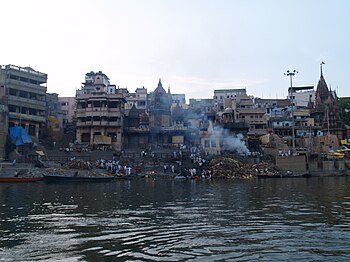
The ongoing pollution of the Ganges, the largest river in the Indian subcontinent, poses a significant threat to both human health and the environment.[1] The river supplies water to approximately 40% of India's population across 11 states[2] and serves an estimated 500 million people—more than any other river in the world.[3][4]
The Ganges is severely polluted with human waste and industrial contaminants. Currently, it is considered the most polluted river in the world.[5] Stretches of over 600 km (370 mi) are classified as ecologically dead zones.[6]
Three-quarters of all the sewage generated in the northern plains remains completely untreated before being discharged into the Ganges and its tributaries.[7]
Several initiatives have been undertaken to clean the river, but they have failed to produce significant results.[8] After being elected, India's Prime Minister Narendra Modi pledged to work on cleaning the river and controlling pollution.[9] Subsequently, in the June 2014 budget, the government announced the Namami Gange project.[10] By 2016, an estimated ₹30 billion (US$460 million) had been spent on various efforts to clean up the river, with little success.[11]
The proposed solutions include demolishing upstream dams to allow more water to flow into the river during the dry season, constructing new upstream dams or coastal reservoirs to provide dilution water during the dry season, and investing in substantial new infrastructure to treat sewage and industrial waste throughout the Ganges' catchment area.
Some suggested remedies, such as a coastal reservoir, would be very expensive and would involve significant pumping costs to dilute the pollution in the Ganges.
- ^ Conaway, Cameron (23 September 2015). "The Ganges River is Dying Under the Weight of Modern India". Newsweek. Retrieved 11 April 2017.
- ^ "Ganga receives 2,900 million ltrs [sic] of sewage daily". www.hindustantimes.com. Archived from the original on 9 September 2015. Retrieved 14 May 2015.
- ^ "The WaterHub". Archived from the original on 3 December 2013. Retrieved 14 May 2015.
- ^ Emily Wax (17 June 2007). "A Sacred River Endangered by Global Warming". Washington Post. Retrieved 25 June 2017.
- ^ Robert Flynn (15 September 2016). Holy Literary License: The Almighty Chooses Fallible Mortals to Write, Edit, and Translate GodStory. Wings Press. p. 96. ISBN 9781609404666. Retrieved 13 July 2017.
- ^ Wohl, Ellen E. 2012. A world of rivers: environmental change on ten of the world's great rivers. Chicago: University of Chicago Press.
- ^ "The race to save the river Ganges". Retrieved 22 February 2021.
- ^ Ganga, Yamuna banks cleaned 12 November 2013
- ^ "How Modi government went horribly wrong on Ganga rejuvenation". 16 October 2018. Retrieved 17 October 2018.
- ^ Cite error: The named reference
bpwas invoked but never defined (see the help page). - ^ Mohit Dubey (2 August 2016). "RTI revelation: Rs 3000 crore spent on Ganga 'clean-up' without visible results". The Economic Times. Retrieved 25 June 2017.